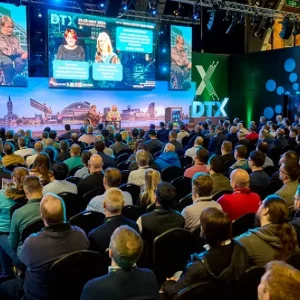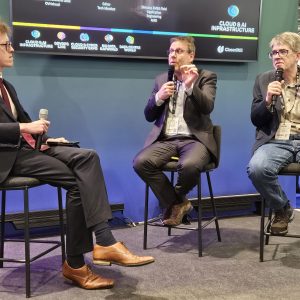
Technological innovation caused climate change. Almost every invention designed to improve the individual’s lot in the past century, from the motor cars that sped along our highways to the very bricks within our homes, required electrical power to run or manufacture. That energy, inevitably, was generated by burning coal, gas, or petroleum, belching vast quantities of carbon into the air and condemning the world to decades of rising temperatures and extreme weather events.
Technological innovation also promises to save humanity from the very worst manifestations of unrestrained climate change. Most of that will arrive as fields and fields of wind turbines and solar panels, but private organisations large and small can play their part. Emissions-tracking software, for example, is predicted to play a crucial role in allowing companies to quantify their contribution to climate change – an ethical imperative, but inevitably a legal one, too, with new emissions reporting rules beginning to be implemented at a large scale across the US and the EU.
Many of the most exciting solutions in this regard have come from the open-source software community. The UN’s own representative to this bailiwick, Omar Mohsine, even suggested at this year’s Open Source Summit in Vienna that meaningful technological innovation on behalf of the climate wouldn’t be possible without the hard work those thousands of anonymous developers devoting their free time and energies to the task at hand. That community, Mohsine told his audience, had the potential to “break barriers” and had shown the world that “all of us, everybody here, could be an actor for change.”
Try telling your average multi-million dollar corporation this, says Pini Reznik. The co-founder and CEO of re:cinq, a consultancy which initially sought to use cloud-native and open-source technologies to help companies reduce their climate emissions, Reznik has seen many organisations prioritise more immediate challenges impacting their profit margins than actually acting on their commitments to get greener. “I really hope it will change over time,” says Reznik, “but, at this time, I believe that most companies are just experimenting.”
Fighting climate change, the open-source way
How, then, do you convince CIOs too busy fighting their own corporate wildfires to adopt sustainable, open-source software solutions? The trick, explains Reznik, lies in ditching the ethical argument for adoption and emphasising how new efficiencies accrued from optimization can lead to cold, hard savings. By shutting down unused virtual servers, for example, its services will have an undoubted impact on sustainability – even if that isn’t the primary selling point.
But if most enterprises have not grasped the nettle, that’s perhaps because most don’t feel under pressure to do so – at least, not yet anyway. When they do, this will require new ways of thinking, new engineering initiatives, and solutions that can’t necessarily be bought off the shelf.
That’s clear from those sectors which are already under intense pressure to get ahead of the problem. Power generation and distribution companies were traditionally conservative and slow-moving. Their focus has been on stability and being able to meet peak demand. Rapid innovation using open-source software, therefore, was not historically on the agenda.
But this is changing, says Jonas van den Bogaard, Open Source Office Lead at the Dutch power distribution firm Alliander. At a high level, he explains, national and Europe-wide policies mean the Netherlands is moving from gas, nuclear and “other traditional energy sources to more renewable energy sources, like wind, solar” – and all this while expecting that electricity consumption will triple in the next ten to 20 years as customers are weaned off fossil fuels and adopt technology like electric vehicles.
At the same time, he explains, it must work out how to better predict and manage energy consumption. This means a shift from a traditional focus on peak demand, with the grid being under-utilized for a large amount of time, to a more managed approach.
This demands much better visibility of the grid and a better handle on demand patterns, which in turn demands both digitalization to ensure Alliander is capturing as much data as possible, as well as the right analysis and forecasting tools to exploit that data.
The problem is that the tools to achieve this are not necessarily available, even from its traditional suppliers. “We strategically can see that this challenge to build up these new capabilities and to realize these new innovations [are] too big for us to handle alone,” says van den Bogaard. That means more collaboration with its peers, as well as academics and other non-profit organizations.
Van den Bogaard is also on the technical advisory council of LF Energy, the Linux Foundation community formed to foster a “technology ecosystem to support rapid decarbonisation.” It oversees projects ranging from tracking and analysing energy consumption and production to software for EV charger networks.
Open source accelerates the development of these new platforms, he says, and allows multiple entities to collaborate. “It has been very successful for building up several capabilities,” says van den Bogaard. “Especially in the Netherlands, this change is going at a quite quick pace. So, it’s pushing our organisation to change and to go through that digital transformation.”

Convincing the arch-conservatives
In the case of power companies like Alliander, there are clear drivers for change in the shape of legislation. But this is not the only driver, argues Gabriele Columbro, head of Linux Foundation Europe and the Fintech Open Source Foundation (FINOS.)
Financial firms are conservative, too, he says, but have increasingly turned to open-source development and tooling. This is often because they see it as more efficient to collaborate on tools and processes for common problems – for example, compliance or regulatory obligations which the whole industry must prepare for.
Climate change and sustainability are certainly problems facing the entire sector. Even US-based banks will have reporting obligations around issues such as sustainability reporting. And when it comes to climate finance and sustainability-aligned investing, these are almost existential issues for Wall Street, suggests Columbro.
“It’s both about building in another major risk profile in their investment portfolios,” he says. At the same time, “on the return side, there is a lot of money to be made in picking the right climate scenario as to what happens in the next ten to 20 years, and where you deploy your investment.” Or, to put it another way, Columbro asks whether any real estate investor would consider buying a house on Miami’s waterfront if they knew there was a very high risk of it being underwater in a couple of decades.
Different regions are taking very different approaches, for now. But in the absence of compulsion, “the best chance is to get businesses to see the own advantage for their shareholders,” Columbro says, “[by] making choices that effectively mitigate or slow down climate change.”
But what happens at this level might not feed through to other ways companies can tackle sustainability, says Reznik. The C-suite and risk management department might have a compelling story about investment strategies and ESG, and this might satisfy regulators – for now – and attract investors who believe a “sustainable” company is a better bet in the long term. But, Reznik asks, “how long will that take to trickle down to the development team in a bank?”
And what does it mean for the infrastructure teams? And what does it mean for each underutilised server that is never switched off and continues to guzzle energy, no matter how much work it does?
There are plenty of open-source tools available to help tech teams understand their infrastructure’s impact, including the Red Hat-sponsored Kepler or Re:cinq’s Aether, which allows them to calculate emissions generated by their cloud infrastructure. And these set the scene for practical action to improve sustainability and efficiency.
“Just [at] an infrastructure level, you can reduce the back-end utilization,” says Reznik. “You can improve the utilization by 50% to 70% without too much effort by building better platforms, optimization and right scaling and stuff like that.” Once that is achieved, he says, then you can look at more complex solutions involving better algorithms and tools. And in the meantime, you’ve reduced costs and delivered better service to your customers.
As for the rest, Reznik says, it will be a question of carrot and stick. If tech and business leaders are not working to address sustainability issues, that’s because they’re not having to confront the changes needed, whether that’s writing more efficient code, optimising their systems, or choosing the most sustainable hardware or cloud service providers. But, at some point, they will. In the meantime, they’ll be benefiting from the upstream work done by the likes of van den Bogaard.






